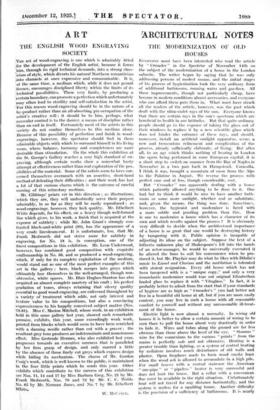ART
THE ENGLISH WOOD ENGRAVING SOCIETY
'i'UE art of wood-engraving is one which is admirably fitted for the development of the English artist, because it forces 'him, through its rigid technical demands, into a strong class- acts' m of style, which diverts his natural Northern romanticism ifsito channels at once expressive and communicable. It is, at the same time, a medium which, while it does not permit !licence, encourages disciplined liberty within the limits of its teelmical possibilities. These very limits, by producing a 'pertain boundary, can promote a perfection which unfortunately may often lead to sterility and self-satisfaction in the artist. For this reason wood-engraving should be in the nature of a by-product rather than an all-absorbing pre-occupation of the artist's creative will ; it should • be to him, perhaps, what ;muscular control is to the dancer, a means of discipline rather than an end in itself. Fortunately most of the artists in this 'society do not confine themselves to this medium alone. :Because of this possibility of perfection and finish in wood- engravings, however, the spectator should find in them admirable objects with which to surround himself in his living room, where balance, harmony and completeness are more desirable than stimulation. On the whole this exhibition at the St. ,George's Gallery reaches a very high standard of en- graving, although certain works show a somewhat hasty attempt at effectiveness rather than real exploration of the pos.. sibilities of the material. Some of the artists seem to have con- cerned themselves overmuch with an assertive, short-hand method of defeating their difficulties ; and their work has lost a lot of that curious charm which is the outcome of careful 'noising of this refractory medium.
Mr. Gibbings' prints err in this direction ; as illustrations, ;which they are, they will undoubtedly serve their purpose 'admirably, in so far as they will be easily reproduced ; as wood-engravings, however, they lack quality. Mr. Ethelbert .White depends, for his effect, on a heavy though well-formed -line which gives, to his work, a finish that is acquired at the expense of subtlety ; while Mr. John Grant's strongly con- trasted black-and-white print (89), has the appearance of a very crude lineoletun-cut. It is unfortunate, too, that Mr. Frank MedWorth did not strive more for subtlety in engraving, for No. 18 is, in conception, one of the !finest compositions in this exhibition. Mr. Leon Underwood, :however, has combined good composition with exquisite ;craftsmanship in No. 36, and so produced a wood-engraving, :which, if only for its complete exploitation of the medium, ' would stand out as one of the most perfect examples of this art in the gallery ; here, black merges into greys which ;ultimately lose themselves in the well-arranged, though non- obtrusive, white spaces. Mr. Blair Hughes-Stanton has also 'acquired an almost complete mastery of his craft ; his perfect gradation of tones, always retaining that silvery quality !essential to good wood-engraving, are enlivened throughout by
variety of treatment which adds, not only interest and ;texture value to his compositions, but also a convincing !expressiveness to his happily conceived subject matter (Nos. 'l'8-81). Miss C. Marion Mitchell, whose work, in an exhibition ',held in this same gallery last year, showed such remarkable 'preirnise; exhibits, this year, some exceedingly weak work, printed from blocks which would seem to have been scratched with a darning needle rather than cut with a graver; the resultant grey tone produces an indeterminate and monotonous effect. Miss Gertrude Hermes, who also exhibited last year, progresses towards an executive sureness that is paralleled by her firm grasp of design, and only marred a little
' by the absence of those finely cut greys which express design while hiding its mechanism. The charm of Mr. Gordon Craig's work, which is well known to the public, is maintained in the four little prints which he sends this year. Other exhibits which contribute to the success of this exhibition are Nos. 11, 14 and 17 by Miss Barbara Greg, No. 21 by Mr. Frank Medworth, Nos. 70 and 72 by Mr. C. C. Webb, No. 85 by Mr. Norman Janes, and No. 7 by Mr. Ethelbert
W. MCCANCE.






















































 Previous page
Previous page